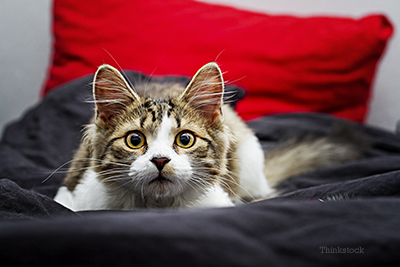
Best be careful about what kinds of noises you make while in the presence of your kitty. This is because some cats, like some humans, suffer from seizures that are triggered by particular noises. A recent study, published in The Journal of Feline Medicine and Surgery, characterized noise-induced seizures in cats.
The research
According to NBC News, The study researchers included:
- Mark Lowrie and Laurent Garosi (veterinary neurologists at Davies Veterinary Specialists in England)
- Robert Harvey (a molecular neuroscientist and geneticist at the University College London School of Pharmacy
This trio refers to the phenomenon of noise-induced seizures in cats as “feline audiogenic reflex seizures” (FARS).
Here’s how the study worked1:
- Guardians of 96 kitties with FARS completed questionnaires
- The cats’ medical records were evaluated
Results
Breeds affected with FARS ran the gamut, including:
- 45 domestic shorthairs
- 30 Birmans
- 5 Burmeses
- 5 domestic longhairs
- 4 Bengals
- 2 Maine Coons
- 1 British Shorthair
- 1 European Shorthair
- 1 Norwegian Forest
- 1 Birman cross
From a statistical point of view, Birman kitties appear to be overrepresented. This suggests a possible inheritance within this breed1.
Results revealed that sound-induced seizures were more common in older cats, with an average age of onset of 15 years. Seizure activity varied from mild twitching, all the way to loss of consciousness and full body muscle contractions1.
Interestingly, all of the sounds triggering seizures were high pitched. The more common sound stimuli identified included:
- Crinkling of tin foil (82 cats)
- A metal spoon dropping into a ceramic feeding bowl (79 cats)
- Crinkling of paper or plastic bags (71 cats)
- Tapping a computer keyboard or clicking the mouse (61 cats)
- Clinking coins or keys (59 cats)
- Clinking or tapping a glass
- Hammering a nail (38 cats)
- A person clicking the tongue (24 cats)
Now here’s where it gets really interesting! All guardians felt they could consistently induce a seizure by making one of the described trigger noises. In fact, for some kitties, the louder or longer the noise, the more severe the seizure.
Treatment
For many of the cats, successful avoidance of exposure to trigger noises completely eliminated seizure activity. Of the 96 kitties, 44 were treated with anti-seizure medication. One drug in particular, levetiracetam (now that’s a mouthful) seemed to be the most effective at controlling sound-induced seizures1.
Tom and Jerry Syndrome
The researchers involved in this FARS study have nicknamed this seizure disorder, “Tom and Jerry Syndrome.” This is because in the Tom and Jerry cartoon, Tom responds to startling noises with involuntary jerks.
What causes FARS?
It isn’t understood why some cats experience noise-induced seizures. Paradoxically, deafness (or hearing impairment) was reported in half of the cats studied1. The researchers have proposed more studies to learn more about this unusual feline syndrome.
If you have any questions or concerns, you should always visit or call your veterinarian -- they are your best resource to ensure the health and well-being of your pets.
Resources:
